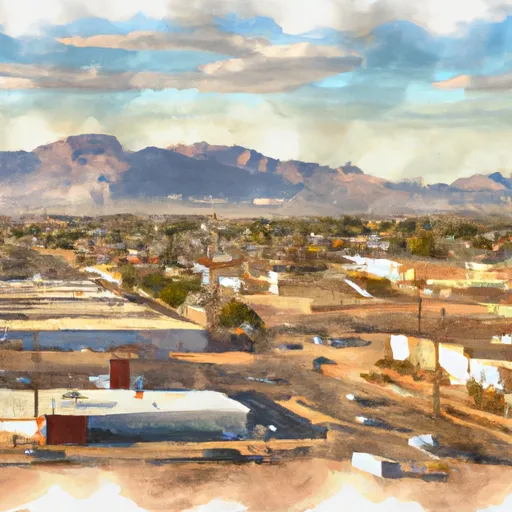-
 Snoflo Premium
Snoflo Premium
Get unlimited access to all our content
With no Ad interruptions! - Start Your Free Trial Login with existing account
Mohave-Valley
Eden Index
Climate
7.2
•
Recreation
6.0
•
Community
1.8
•
Safeguard
5.4/10

Mohave Valley is a small town located in Mohave County, Arizona. Known for its desert landscape, Mohave Valley experiences a hot desert climate characterized by scorching summers and mild winters. Summers are extremely hot, with temperatures soaring above 100°F, while winters are relatively mild, with temperatures averaging around 60°F. The area receives very little rainfall throughout the year.
Hydrologically, Mohave Valley is situated along the Colorado River, providing ample water resources for the region. The river is a popular spot for water-based activities such as boating, fishing, and water skiing. Additionally, there are several lakes in close proximity, including Lake Mohave and Lake Havasu, offering further opportunities for water recreation.
Outdoor enthusiasts will find plenty of recreational activities to enjoy in Mohave Valley. The region boasts numerous hiking trails that showcase the stunning desert scenery and provide opportunities for wildlife observation. Off-roading, camping, and bird-watching are other popular activities in the area. Mohave Valley is also conveniently located near the Mojave National Preserve and the Havasu National Wildlife Refuge, offering additional outdoor exploration options.
What is the Eden Index?
The Snoflo Eden Index serves as a comprehensive rating system for regions, evaluating their desirability through a holistic assessment of climate health, outdoor recreation opportunities, and natural disaster risk, acknowledging the profound impact of these factors on livability and well-being.
Climate Health Indicator (CHI): 7.2
Mohave-Valley receives approximately
132mm of rain per year,
with humidity levels near 47%
and air temperatures averaging around
23°C.
Mohave-Valley has a plant hardyness factor of
9, meaning
plants and agriculture in this region tend to thrive here all year round.
By considering the ideal temperature range, reliable water supplies, clean air, and stable seasonal rain or snowpacks, the Climate Health Indicator (CHI) underscores the significance of a healthy climate as the foundation for quality living.
A healthy climate is paramount for ensuring a high quality of life and livability in a region, fostering both physical well-being and environmental harmony. This can be characterized by ideal temperatures, reliable access to water supplies, clean air, and consistent seasonal rain or snowpacks.
Weather Forecast
Streamflow Conditions
Lower Colorado
Area Rivers
Lower Colorado
Snowpack Depths
Lower Colorado
Reservoir Storage Capacity
Lower Colorado
Groundwater Levels
Recreational Opportunity Index (ROI): 6.0
The Recreational Opportunity Index (ROI) recognizes the value of outdoor recreational options, such as parks, hiking trails, camping sites, and fishing spots, while acknowledging that climate plays a pivotal role in ensuring the comfort and consistency of these experiences.
Access to outdoor recreational opportunities, encompassing activities such as parks, hiking, camping, and fishing, is crucial for overall well-being, and the climate plays a pivotal role in enabling and enhancing these experiences, ensuring that individuals can engage in nature-based activities comfortably and consistently.
Camping Areas
| Campground | Campsites | Reservations | Toilets | Showers | Elevation |
|---|---|---|---|---|---|
| Moabi Regional Park | 150 | 479 ft | |||
| Big Bend of the Colorado Rec Area | 24 | 503 ft | |||
| Needle Mt Road Dispersed | None | 808 ft | |||
| Davis Camp - Mohave County | None | 580 ft | |||
| Sportsman Paradise | None | 539 ft | |||
| Katherine Landing - Lake Mead National Rec Area | 173 | 672 ft | |||
| Lake Havasu Dispersed - RT 95 Area | None | 799 ft |
Nearby Fishing
Nearby Ski Areas
Catastrophe Safeguard Index (CSI):
The Catastrophe Safeguard Index (CSI) recognizes that natural disaster risk, encompassing floods, fires, hurricanes, and tornadoes, can drastically affect safety and the overall appeal of an area.
The level of natural disaster risk in a region significantly affects safety and the overall livability, with climate change amplifying these risks by potentially increasing the frequency and intensity of events like floods, fires, hurricanes, and tornadoes, thereby posing substantial challenges to community resilience and well-being.
Community Resilience Indicator (CRI): 1.8
The Community Resilience Indicator (CRI) recognizes that education, healthcare, and socioeconomics are crucial to the well-being of a region. The CRI acknowledges the profound impact of these elements on residents' overall quality of life. By evaluating educational resources, healthcare accessibility, and economic inclusivity, the index captures the essential aspects that contribute to a thriving community, fostering resident satisfaction, equity, and social cohesion.

